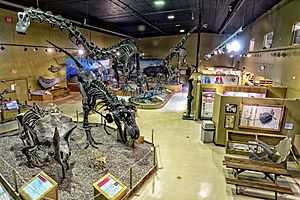Wyoming Dinosaur Center facts for kids
 |
|
| Established | 1995 |
|---|---|
| Location | 110 Carter Ranch Rd. Thermopolis, Wyoming, United States |
| Type | Nonprofit |
The Wyoming Dinosaur Center is a cool museum in Thermopolis, Wyoming. It's special because it has real dinosaur dig sites nearby! You can even visit them. The museum also shows off amazing fossils. One of its most famous displays is the Thermopolis Specimen of Archaeopteryx. This is a very rare fossil of an ancient bird-like dinosaur. It's one of only two real Archaeopteryx fossils you can see outside of Europe.
Just a short 15-minute drive from the museum, you'll find many active dig sites. These sites are on the Warm Springs Ranch. Over 10,000 dinosaur bones have been found and dug up there! Most of these bones are now on display or stored safely at the museum.
One amazing dig site is called "Something Interesting," or SI for short. Here, scientists found both dinosaur footprints and actual bones. Imagine seeing tracks made by huge Sauropods and the fierce Allosaurus! They also found bones from Camarasaurus, Diplodocus, and Apatosaurus. These three types of long-necked sauropods were common in the area during the Late Jurassic period. Many of the bones belong to a young Camarasaurus that was about 30 feet long. It looks like Allosaurs scavenged, or ate, parts of this dinosaur. Scientists know this because they found teeth and claw marks on the bones. They also found over 100 shed Allosaur teeth among the bone pieces! Research from 2006 showed that these bones gathered in a shallow, salty lake long ago. There are even two layers of bones, showing how the lake grew and shrank over time.
Contents
Dinosaur Dig Sites
The Wyoming Dinosaur Center has many exciting dig sites.
Famous Dig Sites
- "Foot Site" (FS): This site has parts of at least three young diplodocid dinosaurs. Their hands and feet are still connected, which is rare!
- "There You Are" (TYA): This site holds the remains of several Allosaurs.
- "Above There You Are" (ATYA): This newer site has bones from what seems to be a single, very young Diplodocid.
- "Beside Sauropod" (BS): This is one of the oldest sites, active for over 20 years. It has produced more than 1,800 bones! Here, they found at least six Camarasaurs and part of an Apatosaur. They also found dozens of shed Allosaur teeth.
Other Dig Sites
There are many other inactive sites around the property. Some of their fun names include "Don't Fall," "Bone Bed," "Laura's Apatosaur," and "Cheryl's Blind." Most of the bones found at all these sites belong to four main types of dinosaurs: Apatosaurus, Camarasaurus, Diplodocus, or Allosaurus.
During the winter, the outdoor dig sites are closed. But in the summer months, from late May to mid-September, you can see active digging happening every day, if the weather is good!
Amazing Collections and Exhibits
The museum is open all year round. It has a huge gallery with over 50 mounted dinosaur skeletons.
Giant Dinosaurs on Display
One of the biggest stars is a full skeleton of Supersaurus vivianae. This giant was dug up near Douglas, Wyoming. The replica skeleton you see is an incredible 106 feet long! It's the first one built using information from "Jimbo" (WDC DMJ-001). Jimbo is the most complete Supersaurus ever found, and it was given to the museum in 2003.
Other cool dinosaurs you'll see include a T rex, Triceratops, Medusaceratops, and different kinds of Hadrosaurs, Stegosaurs, and Allosaurs. One of the newest additions is an almost 90% complete Camarasaurus skeleton. Museum staff and visitors found and dug up its bones over the last 20 years right on the museum's property!
Ancient Life Displays
The museum also has a collection of real and replica marine reptiles (sea creatures) and flying reptiles. They even have impressive fossils from before and after the time of dinosaurs. You can see many ancient fish and invertebrates (animals without backbones) from the Devonian period. More recent displays include fossils of camels, horses, rodents, and nimravids, which were like ancient saber-toothed cats.
Fossil Preparation Lab
The museum has a working preparation lab. Here, you can watch staff and even visitors cleaning, fixing, and preserving fossils. These fossils come from the museum's own dig sites and other places across the country. This work goes on all year long!
Exciting Programs
The Wyoming Dinosaur Center offers many programs where visitors can actually help dig up dinosaurs!
Dig for the Day
The "Dig for the Day" program starts in late May, depending on the weather. This program is perfect for families and individuals who want to learn about paleontology, which is the study of fossils. The "Dig for the Day" starts at 8 AM and finishes at 5 PM. All fossils found during the program stay at the museum for science and research.
Kids' Dig
Throughout the summer, there are many dates available for the "Kids' Dig." Children aged 8 to 12 can learn all about what the Wyoming Dinosaur Center does. They get to dig for fossils, work in the prep lab to clean bones, and even learn how to make molds and casts of fossils.
Other Programs
Other exciting programs include "Dinosaur Academy," "Senior Activities," and the "Paleo Prep program."
Gallery
-
A fossil sea turtle on display
-
A pair of replica Othnielia spar
-
A fossil turtle from the Green River Formation in southwestern Wyoming








